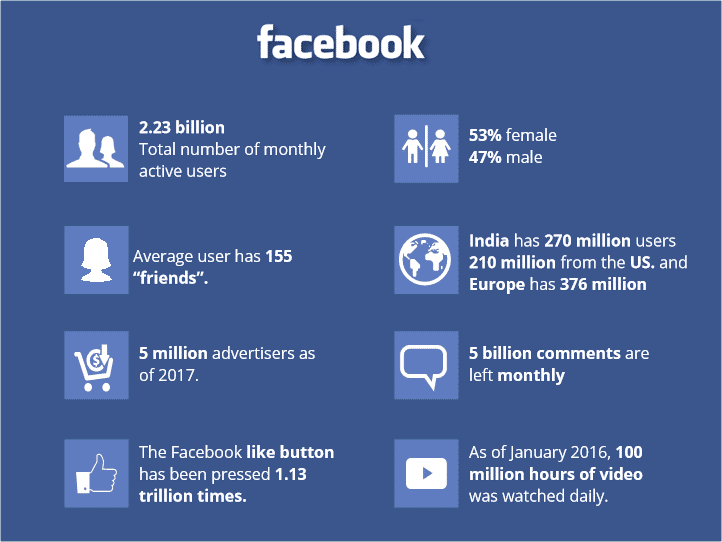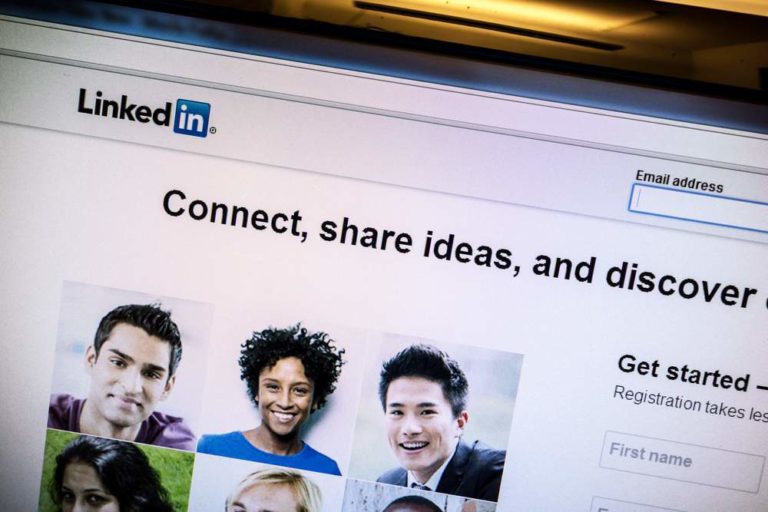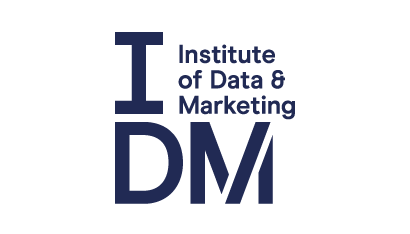Social media platforms overview: Part 1
The social media landscape is ever-changing. Each platform must keep evolving to keep up with competitors, user expectations and shifting regulatory conditions.
Before picking your platform, it’s critical to have an understanding of their business objectives and how you can best leverage them to reach your audience in meaningful ways.
Founded by Mark Zuckerberg in 2004, today Facebook is the predominant social media platform for a number of brands. As it doesn’t lean towards any specific demographics, it is almost a universal platform in most developed countries.

To download a detailed description of this visual, scroll to the “Downloads” section at the bottom of this step.
Offering a complete suite of tools, Facebook is a highly effective advertising platform with a huge reach. But that’s not all. Having acquired a number of other technology companies in the past few years, such as Instagram, WhatsApp and Oculus VR, Facebook has been able to integrate market-leading services into its platform.
Consequently, the marketing opportunities have become wider and more innovative, allowing users to respond to the ever-evolving media landscape as well as the customer expectations that come with it.
Most recently, live videos have shown to be an incisive tool, which Facebook is keen to promote. Given their desire to show off this feature you may find that live videos have an inflated reach over other content formats.
Another one of Facebook’s core strengths is its ability to build online communities. Much of this is down to the way comments are structured to foster lively conversation. This type of interaction with customers is a strong tool for any brand, as long as the comments are monitored and addressed in a timely manner.

To download a detailed description of this visual, scroll to the “Downloads” section at the bottom of this step.
Another internal tool which is receiving a lot of attention is Facebook Groups. This feature is growing in popularity, as it provides spaces for users to congregate and discuss common passions. Because of the internal focus provided by Facebook, content coming from Groups tends to get higher rates of organic reach.
It is no coincidence that an increasing number of brands are creating and actively administering groups focused on the brand itself and its core products and services. The aim is to create an authentic community engaged with the brand and its pages.
Founded in 2010 as a photo-sharing platform, Instagram has grown into the leading platform for visual content. Unlike other social media platforms, Instagram has not experienced drastic changes since its launch. Today its functionality and scope are the same as they were a decade ago.

To download a detailed description of this visual, scroll to the “Downloads” section at the bottom of this step.
In 2016, Instagram introduced Stories. This feature, which is strikingly similar to Snapchat’s core functionality, gave users the chance to temporarily share images and videos on their accounts. This integration has helped increase user engagement and the average users now use the app for almost one hour every day.
While initially slow to adapt, brands are finally embracing Stories as an effective channel for content formats, like informal daily updates, behind the scenes, staff takeovers and live videos. Moreover, Instagram has also introduced retail features for businesses. You can now connect a product catalogue and sell products directly within the app.

To download a detailed description of this visual, scroll to the “Downloads” section at the bottom of this step.
Since being acquired by Facebook, the advertising is controlled through Facebook’s Ad Manager platform, allowing marketers to run and monitor wide-ranging content campaigns from one place.
Launched in 2006 as an SMS-based social network (the 140 character limit was based on the text message limit) Twitter has grown into the world’s real-time information network.
Whilst ostensibly similar to Facebook – you can now post text, images and video – Twitter users interact with it very differently. Unlike other social media platforms, Twitter is not a place to enjoy visual content, watch funny videos or catch up with friends. On Twitter, people listen to, and join, current conversations on a variety of events, from TV shows and sports matches to conferences and political moments.

To download a detailed description of this visual, scroll to the “Downloads” section at the bottom of this step.
Twitter is very much about real-time events. This is reflected in the different use of hashtags in Twitter compared to Instagram. On the latter, people use hashtags to tag content related to a particular topic of interest, a place, or an object.
On Twitter, the primary use of hashtags is to attach a tweet to a specific conversation that is happening at one particular moment in time.
Unfortunately, many brands miss this crucial point of Twitter, simply reposting content from other networks, links to company products and articles. The core challenge for brands on Twitter revolves around their ability to start valuable conversations, which don’t feel like a one-way feed of corporate marketing.
Founded in 2003, LinkedIn’s success is related to its narrow use – professional networking. LinkedIn is more than a platform for online CVs. It’s a place to look for your next job position, grow your professional network, connect with business influencers, publish different types of content, conduct business development through Sales Navigator, and run multimedia ad campaigns.
Unlike traditional consumer marketing, the main role for a company’s LinkedIn account is usually related to talent acquisition, industry authority building and business development. Depending on the kind of company you work for, LinkedIn could prove to be a valuable tool in driving your wider marketing goals.

To download a detailed description of this visual, scroll to the “Downloads” section at the bottom of this step.
Some of the questions you should ask when considering your use of LinkedIn are: How could your business build a stronger reputation within your industry? Does your company page say all the right things to someone who is considering working for you? Are your key staff profiles up-to-date and ready for a prospect who might be conducting some pre-sales due diligence?
Share this
How to Develop Your Social Media Content Strategy

How to Develop Your Social Media Content Strategy


Reach your personal and professional goals
Unlock access to hundreds of expert online courses and degrees from top universities and educators to gain accredited qualifications and professional CV-building certificates.
Join over 18 million learners to launch, switch or build upon your career, all at your own pace, across a wide range of topic areas.
Register to receive updates
-
Create an account to receive our newsletter, course recommendations and promotions.
Register for free







